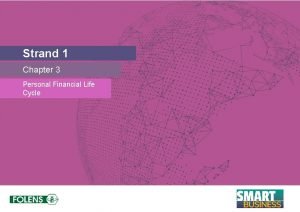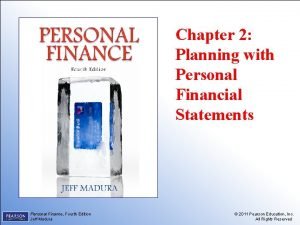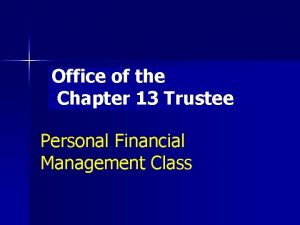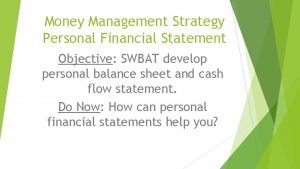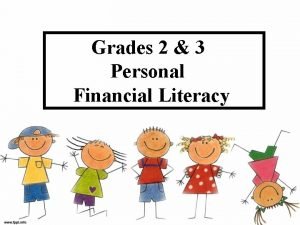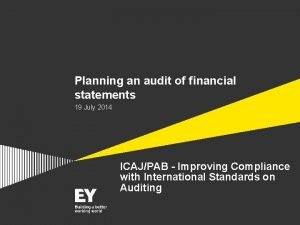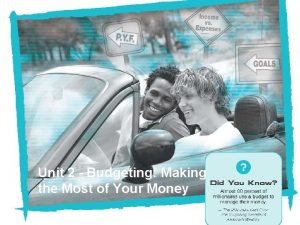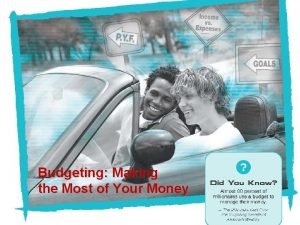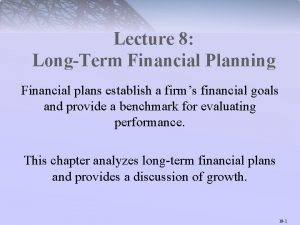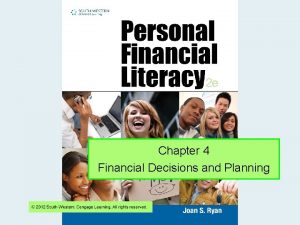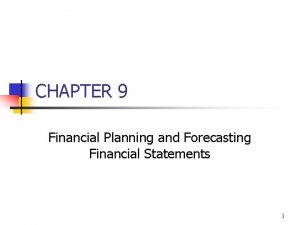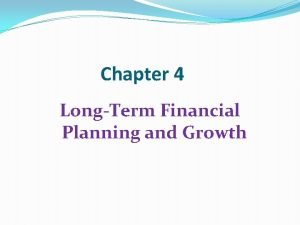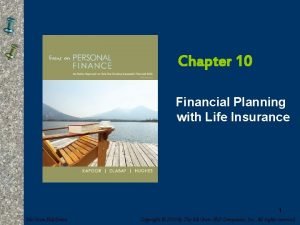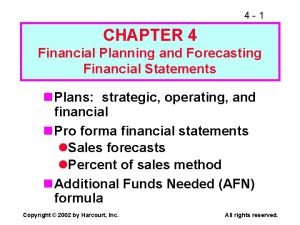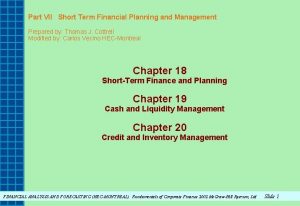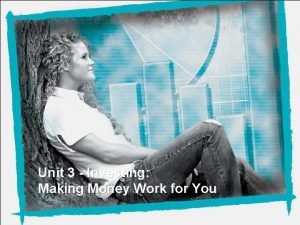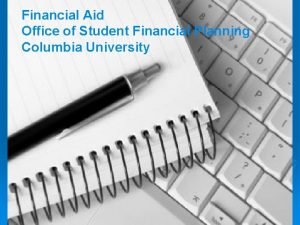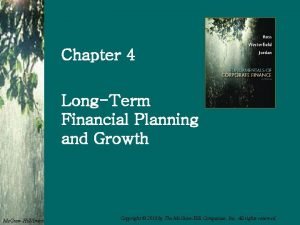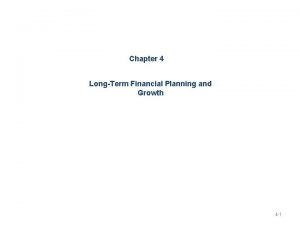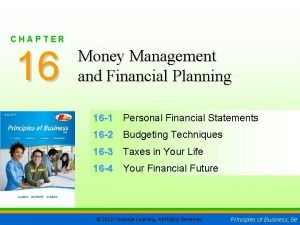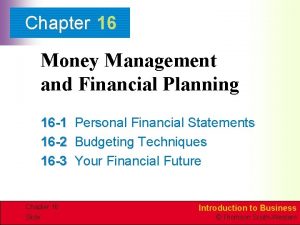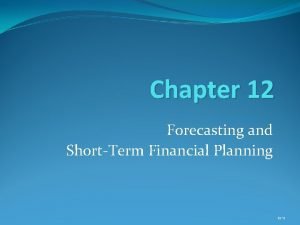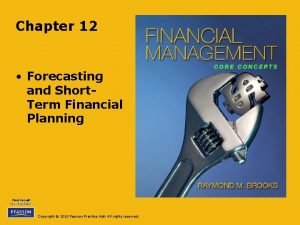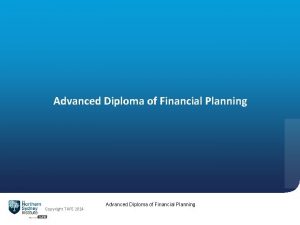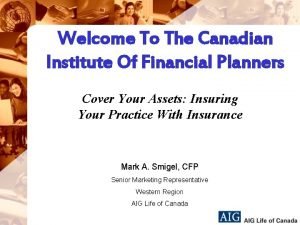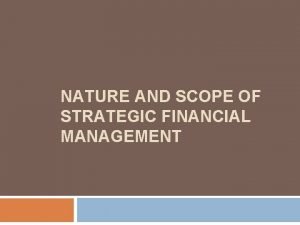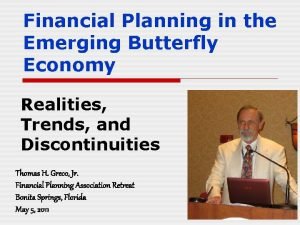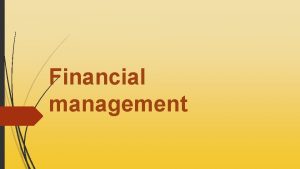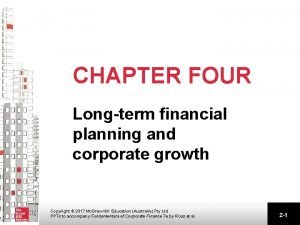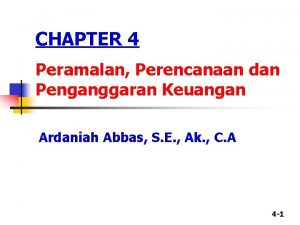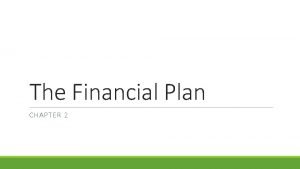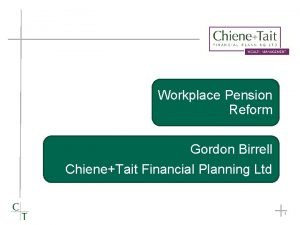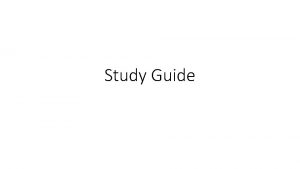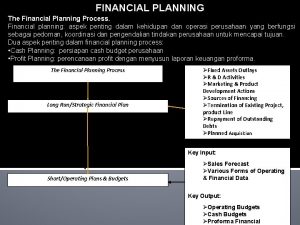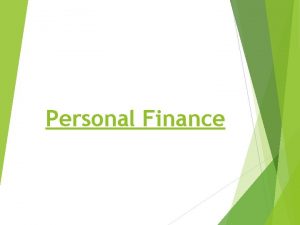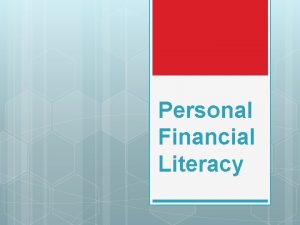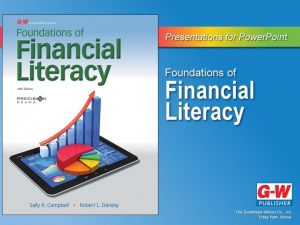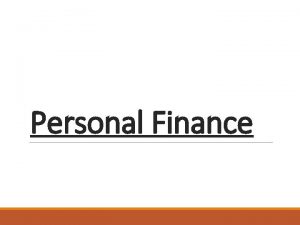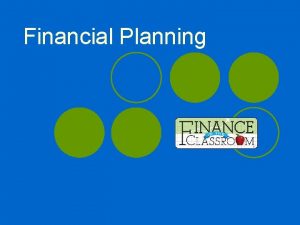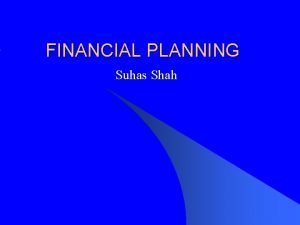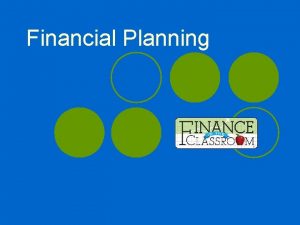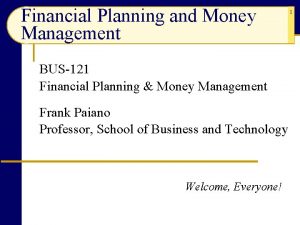Study Guide Study Guide I Personal Financial Planning









































- Slides: 41

Study Guide

Study Guide • I. Personal Financial Planning is arranging to spend, save and invest your money wisely, so you are able to live comfortably, have financial security , and achieve your personal financial goals • A. Goal setting is the foundation of personal financial planning • 1. There are 3 types of financial goals • Short Term Goals are goals that you would like to achieve within 3 months • Intermediate Term Goals are goals that you would like to accomplish within 6 months to a year • Long Term Goals are goals that you would like to accomplish over a year or longer • Unfortunately, most people never reach their f

Study Guide • I. The Concept of Money • A. Money is something that is used for trading, saving, lending, and investing • Money (currency) itself has no real value unless people accept is as something of value • Money in the U. S. is fiat money, meaning the government has deemed it money or legal tender • In the past, people used shells, stones, corn, etc. for money • Modern society uses coins, currency, checks and debit cards for money • Goods and services are directly exchanged using money

Study Guide • B. Functions of Money - Money has 3 basic functions • It’s a medium of exchange meaning it’s used to purchase goods/services in the global marketplace • It’s a standard of value it’s used to measure the value of goods/services • It’s a store of value meaning it holds it’s value and can be stored or saved

Study Guide • C. Properties of money For money to function in an economy, it should possess the following characteristics: • It should be divisible meaning it can be divided into smaller units (eg. a dollar bill can de divided into 4 quarters, etc. ) • It’s Usable meaning you can take it anywhere • It’s Stable meaning money should have stable value; the stability of money is important to an economy; and the federal government takes measures to keep prices stable to avoid inflation (high prices) or deflation (low prices)

Study Guide • D. In today’s global economy each country’s currency has a value that is different from those of other countries • A country’s currency’s value is established, in the Foreign Exchange Market (International Currency Market) • And global currencies are bought and sold in these foreign exchange markets

Study Guide • When currency values are not set by Foreign Exchange Markets, they are set at fixed rates by their governments • The value of one currency in comparison to another currency is called the exchange rate (eg. One U. S. Dollar is worth $13. 35 in Mexican Peso’s) • Exchange rates change from day to day, and from country to country

Study Guide • The amount a country’s currency is worth depends on the number of other countries that want to buy their products; If demand for a countries goods and services increase the value of their currency will increase (eg. If demand for California Wine increases in the global marketplace, the value of the dollar will increase in the global marketplace)

Study Guide • When the value of a country’s currency goes up in comparison to another country’s currency, it is said to appreciate in value, and when it goes down, the currency depreciates in value • Currency exchange rates affect everyone, whether your shopping online for goods from another country or just buying products that were imported from another country

Study Guide • E. Hard Currency (strong currency) is usually the currency of a geopolitical nation 1. These currencies are expected to remain stable, they fluctuate very little over time 2. These currencies are traded throughout the world and have a stable purchasing power 3. Historically, the U. S. Dollar, the Euro and the Swiss Fran are examples of hard currencies

Study Guide • 2. Soft Currency (weak currency) is any global currency that is expected to fluctuate erratically or depreciate against other currencies • The currencies of most undeveloped countries are soft currencies • These currencies fluctuate according to the countries • political or economic status • These currencies are not preferred for international trade • An example of a soft currency would be the Zimbabwean Dollar and the Venezuelan Bolivar • •

Study Guide • I. The money you earn from your chosen occupation or other sources is called Earned Income • A. Types of Earned Income • 1. wages- paid by the hour (eg. $20. 00 per hour) • 2. salary- you receive a set amount of payments (eg. $70, 000 per year) • 3. Commission – amount of money one earns based upon the level of sales he/she has obtained • 4. Bonuses an amount of money added to wages/salary, especially as a reward for good performance

Study Guide • B. Income: • 1. Gross Income-is the total amount of earned income from your wages/salaries before payroll deductions • 2. Net Income- is the total amount of one’s earned income after payroll deductions are deducted (Take Home Pay) • 3. Discretionary Income-money you have left after paying your essentials, such as bills, clothing, transportation costs, etc. • 4. Payroll Deductions- are money subtracted from your gross income; the biggest deduction for most people are payroll taxes

Study Guide • C. Payroll Taxes- money that is deducted from your Earned Gross Income • 1. Federal Income Taxes-fee paid to the federal government to help support federal government programs; this money is collected by the employer each pay period and paid to the IRS (Internal Revenue Service) • 2. State Income Taxes- fee paid to the state where you reside, to pay for state government programs; this money is collected by the employer each pay period and paid to the Treasury Department in the state you reside in

Study Guide • 3. Social Security Tax (FICA)- is a federal program that collects taxes from most employees to fund federal programs for the elderly, the blind and low income families/individuals • 4. Medicare – are taxes collected from most employees to fund medical benefits for individuals 65 years of age or over

Study Guide • D. Taxes are classified as: • 1. Progressive Tax Rate are taxes that impose a higher tax rate on those with higher incomes • 2. Regressive Tax Rate are taxes that impose a higher tax with lower incomes • 3. Proportional Tax Rate imposes the same tax rate on all regardless of income • a. The U. S. has a Progressive Tax Rate • b. The Progressive Income Tax is used as income redistribution, meaning that the taxes paid by those earning higher incomes is used to pay for social welfare programs such as benefits for the elderly and retired, the sick or invalid, dependent survivors, single mothers, unemployed, work injured and low income families

Study Guide D. What is taxed in the U. S. 1. Personal Income Tax- your income 2. Sales Tax-goods/services you purchase 3. Property Tax-real estate 4. Wealth Tax- estate and gift taxes (estate taxes are taxes on property one receives after someone’s death); gift taxes are (taxes on money or property that you give someone during your lifetime, it’s taxed on the basis of its value) • 5. Excise Taxes- are taxes on certain items such as air fare, gasoline, alcohol, tobacco products and phone service • • •

Study Guide • B. Besides earning an Income, many employees receive non-cash compensation which are called Benefits • Benefits include the following • Health Insurance • Life Insurance • Paid Vacation • Pension (retirement plan) • Companies are not required by law to offer or to pay for employee benefits

Study Guide • 1. Types of Mortgages: • Conventional Mortgages are mortgages that are not insured or guaranteed by the federal government • * Fixed rate-mortgage loans have the same interest rate for the entire repayment term • * Adjustable-rate-mortgage loans (ARMs) have an interest rate that will change or "adjust" from time to time • b. Government Mortgages • * FHA Loans The Federal Housing Administration (FHA) mortgage insurance program is managed by the Department of Housing and Urban Development (HUD), which is a department of the federal government • **FHA loans are available to all types of borrowers, not just first-time buyers • **The government insures the lender against losses that might result from borrower default

Study Guide • VA Loans The U. S. Department of Veterans Affairs (VA) offers a loan program to military service members and their families. Similar to the FHA program, these types of mortgages are guaranteed by the federal government • ** The primary advantage of this program is that borrowers can receive 100% financing for the purchase of a home. That means no down payment whatsoever

Study Guide • *USDA / RHS Loans The United States Department of Agriculture (USDA) offers a loan program for rural borrowers who meet certain income requirements • **The program is managed by the Rural Housing Service (RHS), which is part of the Department of Agriculture • **This type of mortgage loan is offered to "rural residents who have a steady, low or modest income, and yet are unable to obtain adequate housing through conventional financing

Study Guide • I. Credit- is an arrangement to receive cash, goods or services now and pay for them in the future • A. Consumer Credit-is the use of credit for personal use • A common form of consumer credit is a credit card account issued by a Financial Institution, such as (eg. Banks, Credit Unions, Merchants, etc. ) • Consumer credit is a major force in the U. S. economy- (any analysis of the U. S economy includes consumer credit spending which is a major force in the economy) • Credit Cards enable consumers to make purchases they may not be able to afford at the moment

Study Guide • B. Types of Credit- 2 basic types of credit • 1. Closed-End Credit-is a one time loan that is paid back over a specified period of time in payments of equal amounts (eg. Vehicle loans, mortgage loans, furniture loans, etc. ) • 2. Open-End Credit-is a loan with a certain limit on the amount of money you can borrow for goods/services (eg. Department store (Macy’s) and bank credit cards (Visa, Master. Card, etc. )

Study Guide • C. Alternative Types of Credit Cards • 1. Debit Cards- Let’s the consumer electronically withdraw money from their checking/savings accounts • 2. Store – Value Cards (Pre-paid cards)- Cards that are prepaid, providing the card holder with immediate money • 3. Travel and Entertainment Cards- (eg. American Express) are not really credit cards, used primarily for business, entertainment and travel; the balance is due in full each month

Study Guide • D. The Language of Credit • 1. APR (Annual Percentage Rate) the cost of using credit; the amount of interest you pay annually • 2. Credit Report is a detailed record of your personal credit and financial transactions • 3. Credit Score is a rating used by companies to help lenders decide whether or not, and how much credit can be extended to borrowers

Study Guide • E. Creditworthiness- Before financial institutions extend credit to consumer they consider the applicant’s Capacity, Character and Capital known as the “ 3 Cs of credit” • a. Capacity is the applicant’s ability to repay the loan • To determine capacity lenders will verify the applicant’s • employment and income • b. Character shows whether he/she has proven to be trustworthy in repaying debts • To determine character they will check the applicants credit report and ask for credit references • c. Capital is the amount of money the applicant has beyond debts • To determine the amount of capital the applicant has, they will look at the applicants savings account, checking accounts and investments

Study Guide • I. Investing • A. Common Stock – is a unit of ownership in a company, that gives the stockholder voting privileges in the corporation (1 vote per share) • This type of stock provides a source of income for the stockholder when dividends (share of the profits) are distributed • Additionally, if the company splits or divides shares into a larger number of shares, the stockholder will gain more shares of the company’s stock. • Most companies generate the money they need by selling common stock

Study Guide • B. Preferred Stock- is a type of stock that gives the owner (stockholder) the advantage of receiving cash dividends before common stockholders receive their cash dividends • If a company is having financial difficulty or failing, Preferred stock holders receive dividends first and any assets that are left before common stockholders receive anything • Preferred stock is more expensive than common stock

Study Guide • C. Types of Stock • Blue-Chip Stocks-are considered a safe investment that generally attract conservative investors. • These stocks are issued by the strongest and most respected companies in their industries, eg. Kellogg’s • These companies are leaders in their industries, have a history of stable earnings, and have a history of consistency in the payment of dividends • These companies usually have a market capitalization in the billions (total dollar market value of all of a company’s outstanding shares

Study Guide • Income Stocks- Are stocks that have a higher dividend yield than other stocks • Dividends are predictable for these type stocks and often increasing • This type of stock is normally issued by companies in mature industries (eg. Utility Companies; Natural Resource Companies, etc. )

Study Guide • Growth stocks- Stock issued by corporations whose potential earnings are predicted to be higher than any other companies in the marketplace • These companies don’t normally pay dividends, but reinvest their earnings • These type of companies are known for producing new, high quality products • These are normally Technology Stocks

Study Guide • Penny Stock-are stocks that typically trade for • $5. 00 or less per share , although they can go as high as $10. 00 per share • These stocks are normally issued by small companies or new companies whose sales are unsteady • These stocks are highly volatile, and are extremely risky for investors • In the U. S. these stocks are traded over-the- counter via Pink Sheets (Daily publication of prices of OTC stocks)

Study Guide • I. Banking- one of the most important components of personal financial planning is managing your finances • A. Today, there are more than 11, 000 banks, 2, 000 savings and loan associations, and 12, 000 credit unions in the U. S. • These financial institutions make money by lending consumers and businesses money via loans • .

Study Guide • 1. There are 3 main types of banks in the U. S. • a. Commercial Banks (Full Service Banks), most of the banks in the U. S. are Commercial Banks • make a profit, they earn this profit by charging much more interest on the money they lend than the interest they pay on savings accounts • * They offer services such as checking/savings accounts, mortgage loans, small business loans, student loans, commercial loans, investment advising, etc.

Study Guide • b. Savings and Loan Associations • These banks were originally established to offer savings accounts and home mortgages (they charged lower interest rates on loans and higher interest rates on savings accounts) • In the 1980’s, 20% of Savings and Loan Associations failed , so the government passed new regulations that allowed them to charge higher interest rates and offer more services like credit cards

Study Guide • c. Credit Unions Member owned financial institution • Credit Unions are formed by large corporations and organizations for their employees • Credit unions are Not-For-Profit Organizations because their purpose is to serve their customers not to maximize their profits • Credit unions offer their members competitive rates, and other financial services to their members

Study Guide • B. Types of Financial Services • 1. Savings Accounts • Regular Savings Account- are good if you make frequent deposits and withdrawls; they require little or no minimum balance; however the interest earned on these type of accounts are relatively low compared to other savings options • Certificates of Deposit (CD) is a savings option in which money is deposited for a stated period of time, to earn a specific rate of return (interest); offers a higher interest rate than a regular savings account • Money Market Accounts type of savings account offered by banks and credit unions that pay higher rates, have higher minimum balances than regular savings accounts; Minimum balance is $1000 -2500, and only allow 3 -6 withdrawls a month • U. S. Savings Bonds- (Patriot Bonds) are another savings option; you can purchase these bonds from the federal government in amounts that range from $25 - $5, 000. 00

Study Guide • 2. Payment Servicesare the 2 nd category of financial services; the • most commonly used payment services are checking accounts • Types of Checking Accounts • Regular Checking Accounts- usually do not require minimum balances • Interest Earning Checking Accounts are a combination of checking and savings accounts; these accounts pay interest if you maintain a specific minimum balance • “Many checking accounts offer overdraft protection, which is an automatic loan to cover checks that the balance in the account won’t cover” • •

Study Guide • 3. The 3 rd category is Borrowing- If you need to borrow money, financial institutions have many options for borrowing the following: – – Auto Loans Mortgage Loans Personal Loans Student Loans • 4. The last category of financial services are other financial services such as financial planning services, income tax assistance, bond and mutual fund investment assistance, etc. – Financial Planning Services – Income Tax Assistance – Investment Assistance, etc.

Study Guide • 2. Check Cashing Outlets – There are more than 6, 000 check cashing outlets in the U. S. – You are not required to have an account with these organizations – They charge anywhere from 1 -20% of the face value of a check, however the average is 2 -3% – For low income families these rates can be a • significant portion of their household budget – They also offer other services such as utility bill payments, money orders, private postal boxes, etc.

Study Guide • 3. Payday Loans – Also known as cash advances, check advance loans, and delayed deposits – Interest rates range from 659 -1300% – These type of financial institutions have increased in recent years due to the economy – The most frequent user of these types of institutions are workers who are trapped by debt, or people who have been driven into debt by misfortune
 Personal financial planning life cycle
Personal financial planning life cycle Personal financial planning life cycle
Personal financial planning life cycle Chapter 2 personal financial planning answers
Chapter 2 personal financial planning answers Examples of non financial methods of motivation
Examples of non financial methods of motivation Personal branding for financial advisors
Personal branding for financial advisors Chapter 13 personal financial management course
Chapter 13 personal financial management course Personal statement of financial position
Personal statement of financial position Personal financial literacy teks
Personal financial literacy teks Audit planning memorandum ey
Audit planning memorandum ey High school financial planning program answer key
High school financial planning program answer key Nefe high school financial planning program answer key
Nefe high school financial planning program answer key Financial planning models
Financial planning models Chapter 4 financial decisions and planning
Chapter 4 financial decisions and planning Chapter 4 financial decisions and planning
Chapter 4 financial decisions and planning Financial planning and forecasting
Financial planning and forecasting Long term financial planning process
Long term financial planning process Chapter 10 financial planning with life insurance
Chapter 10 financial planning with life insurance Financial planning and forecasting
Financial planning and forecasting Fp solutions financial planning software
Fp solutions financial planning software Long term financial planning
Long term financial planning Nefe high school financial planning program answers
Nefe high school financial planning program answers Financial planning columbia
Financial planning columbia Long term financial planning and growth chapter 4
Long term financial planning and growth chapter 4 Sustainable growth equation
Sustainable growth equation Chapter 16 money management and financial planning
Chapter 16 money management and financial planning Chapter 16 money management and financial planning
Chapter 16 money management and financial planning Short term financial planning
Short term financial planning Financial planning and forecasting problems with solutions
Financial planning and forecasting problems with solutions Financial planning tafe
Financial planning tafe Store layout design and visual merchandising ppt
Store layout design and visual merchandising ppt Canadian institute of financial planning
Canadian institute of financial planning Financial planning basics for doctors
Financial planning basics for doctors Strategic financial management outlook is what in nature
Strategic financial management outlook is what in nature Butterfly financial planning
Butterfly financial planning Financial planning vocabulary
Financial planning vocabulary Financial analysis planning and forecasting
Financial analysis planning and forecasting Dimensions of financial planning
Dimensions of financial planning Planning budgeting forecasting
Planning budgeting forecasting What is short term financial planning
What is short term financial planning Chapter 2 the financial plan
Chapter 2 the financial plan Research paper on financial planning and forecasting
Research paper on financial planning and forecasting Least workplace
Least workplace

